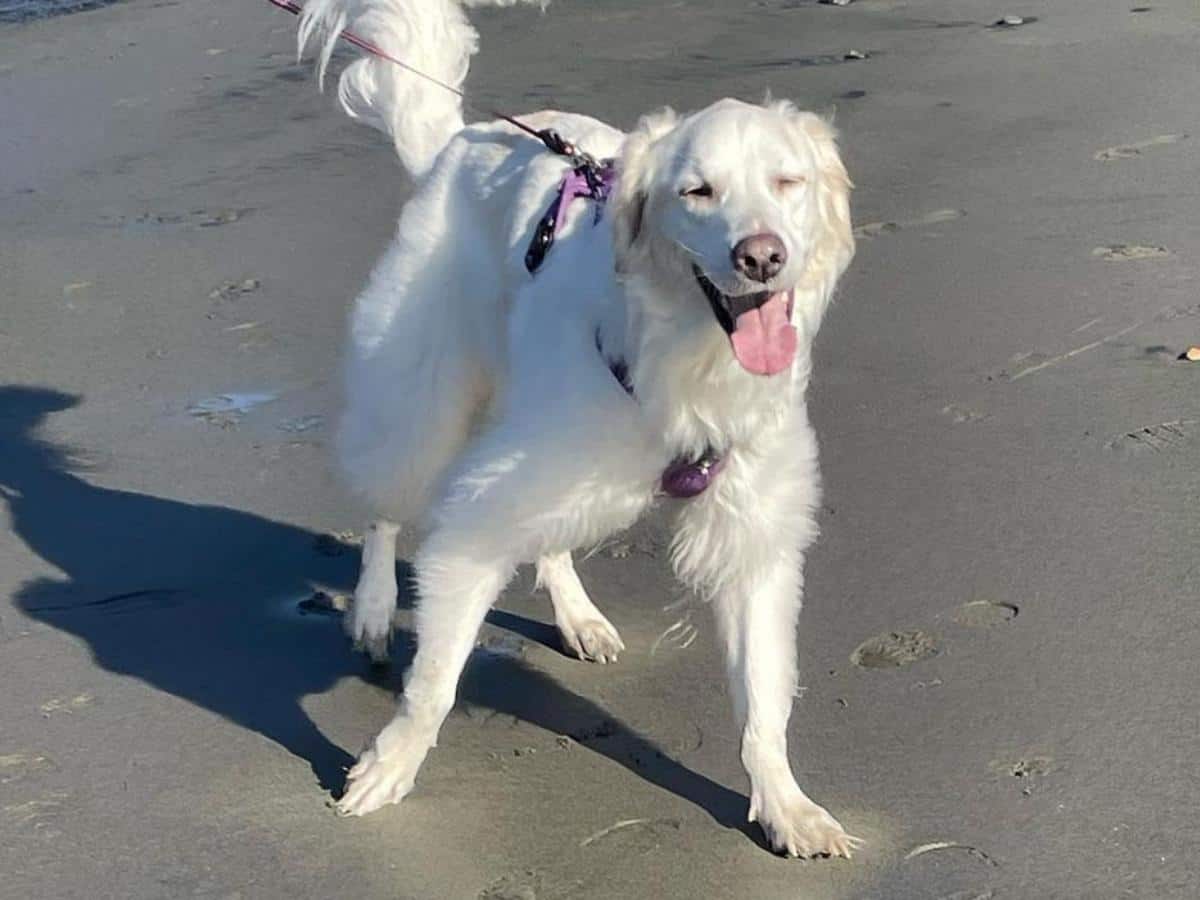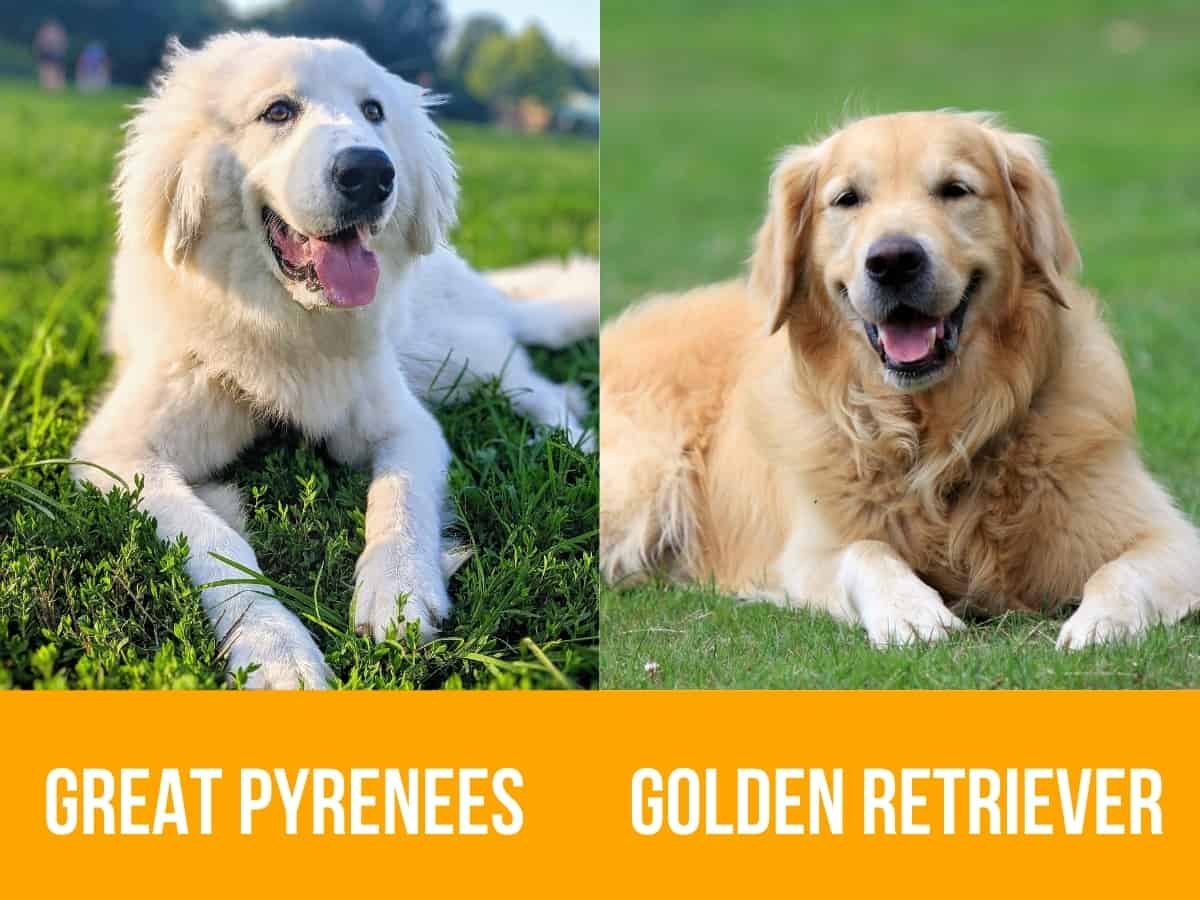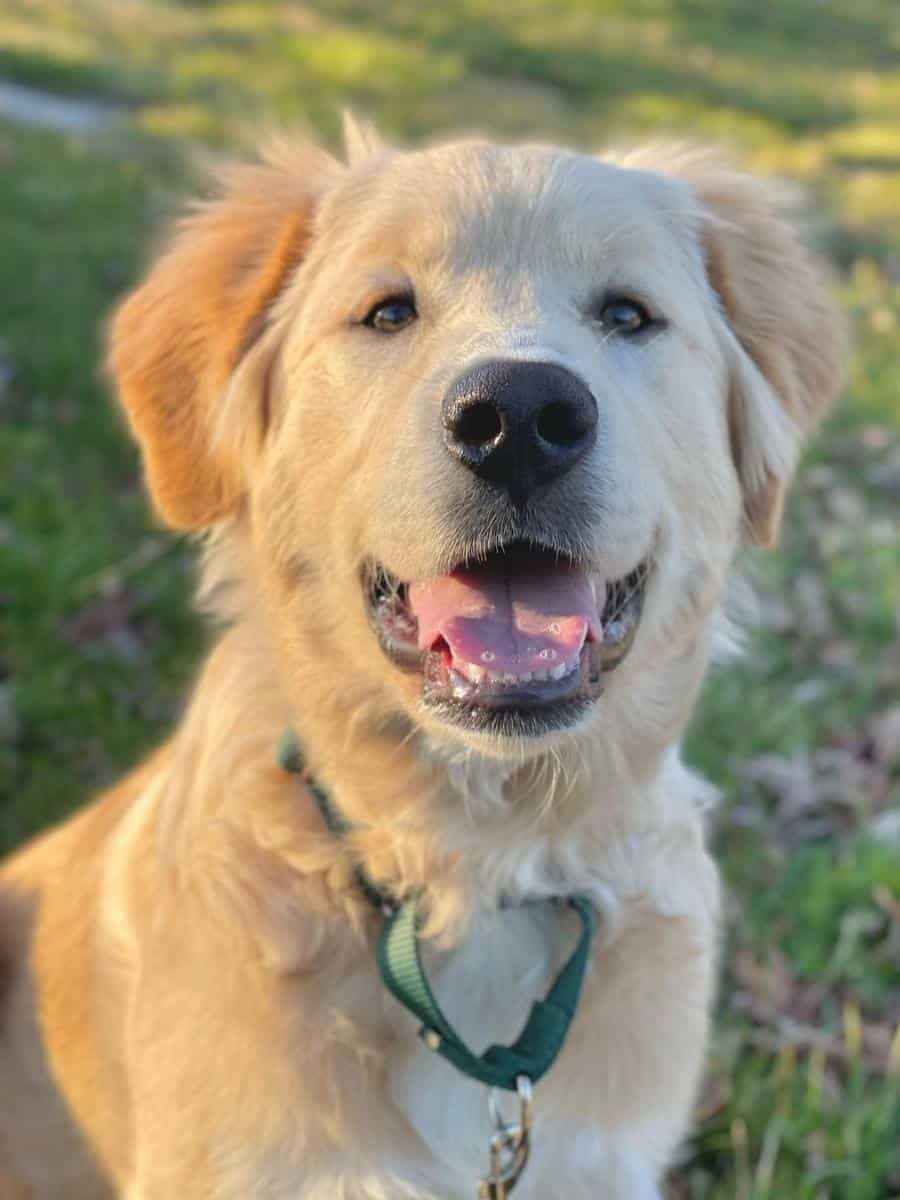Welcome to our exploration of the Golden Pyrenees, a magnificent crossbreed between the Golden Retriever and the Great Pyrenees.
Known for their loyalty, affection, and majestic presence, the Golden Pyrenees are more than just pets; they’re heartwarming companions for families and individuals alike.
Join us as we delve into these gentle giants and the unique blend of qualities that make the Golden Pyrenees a perfect addition to any home.

Origin and History
Let’s start off with a brief description of the origin and history behind the Golden Pyrenees. But if you’re in a hurry, here’s a quick breed profile:
| Golden Pyrenees | Breed Characteristics |
|---|---|
| Type | Working / Companion |
| Other Names | Golden Retriever Great Pyrenees Mix, Great Pytreiver, Great Golden, Golden Pyr |
| Breed Size | Large |
| Height | 23-32 inches (Males) 21.5-29 inches (Females) |
| Weight | Between 65 to 100lbs (Males) Between 55lbs to 85lbs (Females) |
| Temperament | Friendly, Patient, Calm, Outgoing, Playful, Brave, Protective, Guard-dog, Willing, Trainable, Loyal, Intelligent, High-energy |
| Appearance | Majestic, Elegant, Broad Skull, Well-balanced Muzzle, Black or Brownish-black Nose, Brown Eyes, Long and Well-plummed tail, Medium-sized Ears (carried flat to the cheeks) |
| Lifespan | 10-12 years |
| Health Issues | Cancer, Bloat (GDV), Bone and Joint Issues, Ear and Eye Problems, Addison’s Disease |
| Coat Colors | Golden, White, Mix of White and Gold, With or without markings |
| Coat Type | Double-coated, Medium or Long, Straight or Wavy |
| Shedding | Heavy |
| Grooming | Moderate |
| Easy to Train | Yes |
| Exercise Needs | Medium-High |
| Hypoallergenic | No |
| Child Friendly | Yes |
| Pet Friendly | Yes |
| Good for new owners | Yes |
| Cost | $500 – $1,000 |
What is a Golden Pyrenees?
The Golden Pyrenees are not purebred. It is a crossbreed of the Golden Retriever and the Great Pyrenees.
The parent dogs are quite different in physical and personality traits. However, crossbreeding a Golden and Pyrenees brings out the best of these dogs in the resulting puppy.
The ‘Golden Pyrenees’ is the official name to register these hybrid dogs. However, the Golden Retriever Great Pyrenees mix is sometimes called Great Pytreiver. You may also find unofficial terms such as ‘Great Golden’ and ‘Golden Pyr.’
The Golden Pyrenees does not have an official breed standard as a crossbreed dog. To understand the Great Pyrenees Golden Retriever mix, you’ll have to understand the parent breeds.
Golden Retriever
There’s a reason Golden Retrievers appear among the top 5 in several lists, including the AKC’s most popular breeds and Stanley Coren’s The Intelligence of Dogs. This dog is intelligent, friendly, loyal, and loves to please.
Goldens are outgoing and will get along with family, strangers, children, and other dogs and animals. Besides, you can quickly train a Golden Retriever using its favorite treats to reward desired behavior.
Since they are so intelligent and willing to please you, you don’t need to repeat commands multiple times, as your Golden will learn and execute them fast.
These are some of the great traits Dudley Marjoribanks, 1st Baron Tweedmouth, desired when he crossed several breeds to create a fast, energetic, and loyal dog – the Golden Retriever.
Goldens were initially water and land retrievers, and they made faithful and obedient hunting companions.
Golden Retrievers arrived in the United States in the early 1900s, and the AKC recognized them as a breed in 1925.
The popularity of Golden Retrievers has spread widely since then. Today, Golden Retrievers take the 3rd position in the 2022 most popular dog breeds list.

Great Pyrenees
The Great Pyrenees is a snowstorm at first glance. Its snow-white fur gives it an air of majesty, even though some Pyrs can come with markings. The Pyr is a good dog known for its patience and affection for family.
However, a Great Pyrenees can also be a blazing fire if someone threatens their family as they have acute guarding and protective skills.
You’ll need to train your Pyrs to be social and work with them to control their instinct to bark when the dog is a puppy. The Pyr’s strong-willed nature also warrants early training.
These traits describe the sheep guard dog bred by the French of the Pyrenees Mountains around 3000 BCE. The Pyr’s guarding skills were refined under the freezing temperatures of the mountains.
The Great Pyrenees is also considered France’s royal dog for protecting the king’s castle in the 17th century.
At some point in history, Great Pyrenees dogs decreased in numbers with the decline in sheep predators. But their arrival in North America and their registration by the AKC in 1933 helped revive this royal breed.
The Great Pyrenees is the 70th most registered dog, going by the AKC records.
Appearance, Coat, and Colors
Being a crossbreed, it is difficult to precisely predict what your Great Pyrenees Golden Retriever mix will look like.
Nonetheless, you can expect some of the parent breeds’ prominent physical and temperament traits to characterize your Golden Pyrenees Golden Retriever mix.
Let’s explore the Great Pytreiver’s appearance. But first…
Watch This Cute Golden Pyrenees Puppy on YouTube…
General Appearance
Taking from both the Golden Retriever and the Great Pyrenees, your Great Pytreiver will be well put together. The crossbreed will adorn the majesty and elegance of the Pyr and show the symmetry of the Golden Retriever.
In addition, your Golden Pyrenees will display the regal expression of the Pyr with an incorporated aspect of the kindly yet alert and confident expression of the Golden Retriever.
Coat Type and Color
The Golden Retriever and Great Pyrenees have a lot in common regarding coat type, and you’ll likely see an even fusion of the two coats in your Golden Retriever Great Pyrenees mix.
First, your Golden Pyrenees pup will have a weather-resistant double coat that could be coarser like the one of the Pyr or take a softer texture after the Golden.
The fur may be straight or wavy depending on their Golden parent or flat after their Pyr parent. The length of the fur may vary from medium to long.
The Great Pyrenees and the Golden Retriever have heavier feathering on the neck, back, and tail. These aspects are likely to be reflected in the Golden Pyrenees puppy.
The Golden Pyrenee’s puppy coat can be golden in color after their Golden Retriever parent or pure white like their Great Pyrenees Parent.
Alternatively, the puppy could come with a mixture of white and golden (dark or light) or bear reddish-brown, gray, tan, or badger markings from the Pyr parent.

Other Features
You should also expect some of these appearance elements when you crossbreed a Golden Retriever and a Great Pyrenees:
- Head: Broad skull with a possible slight wedge shape and a wide and deep fore face. The head is proportionate to the body.
- Muzzle: The muzzle will tend more to a well-balanced length and head skull as with the Pyr parent or show more of the straight Golden muzzle that blends smoothly and firmly into the skull.
- Eyes: Medium-large eyes with the friendly and intelligent expression of the Golden Retriever. The eyelids fit closely. The color of the eyes is dark brown, like that of the parent breeds.
- Nose: Black from both parents, with a possibility for a brownish-black nose from the Golden Retriever parent.
- Ears: Small to medium-sized ears, carried flat and close to the cheeks.
- Tail: Long, extending to the hock. It may be well plumed as that of the Pyr. The tail carriage may vary from low to level and have a moderate upward curve. The tail might also extend over the back like the Pyr.
Golden Pyrenees Size
A male Golden Pyrenees will grow to around 23-32 inches (58.4-81.3cm) at the withers, while a female will grow to about 21.5-29 inches (54.6-73.7cm).
A male Golden Pyrenees weigh approximately 65 to 100 lbs (29.5 to 45.4kg), while a female will weigh about 55 to 85 lbs (24.9 to 8.6kg).
These Golden Pyrenees’ sizes are estimated from the size of the parent breeds as shown:
| Golden Retriever | Golden Pyrenees | Great Pyrenees | |
| Male Height | 23-24 inches (58.4-61.0 cm) | Between 23-32 inches (58.4-81.3 cm) | 27-32 inches (68.58-81.28 cm) |
| Female Height | 21.5-22.5 inches (54.6-57.2 cm) | Between 21.5-29 inches (54.5-73.7 cm) | 25-29 inches (63.5-73.66 cm) |
| Male Weight | 65-75lbs (29.5-34.0 kg) | Between 65 to 100lbs (29.5 to 45.4 kg) | 100lbs (45.35 kg) or more |
| Female Weight | 55-65lbs (24.9-29.5 kg) | Between 55lbs to 85lbs (24.9-38.6 kg) | 85lbs (38.55 kg) or more |
Golden Pyrenees Temperament
Temperament is the main aspect used to describe a good dog, especially the dog’s capacity to be friendly with family and other people and animals.
These temperament traits are directly influenced by your puppy’s breed, which means crossbreeds will mainly inherit their temperament characteristics from the parent breeds.
Golden Pyrenees are good dogs because they are affectionate with their family. They are also good with children, other dogs, and strangers.
Golden Pyrenees also have a high level of adaptability and trainability, making them well-suited for many families.
If you are looking for a guarding dog, the Golden Pyrenees is also a good dog as it inherits guarding traits from both parents. These traits include a protective nature and a tendency to bark (especially in the Great Pyrenees).
Also, when considering the Great Pytreiver as a family dog, it’s essential to know that the crossbreed could come with some downsides, including:
- Excessive shedding (both parents are heavy shedders).
- A bit of stubbornness from the Pyr parent.
- Being extra vocal, like their Pyr parent.
Both the Pyr and the Golden have high mental stimulation needs and require a high level of exercise.
These needs make the Golden Retriever Great Pyrenees cross suitable for someone who has the time to provide daily exercise and keep their Golden Pyrenees mentally stimulated.

Caring for a Golden Pyrenees
If you’re considering getting this crossbreed, you must know how to care for it.
Shedding and Grooming
Considering that both the Great Pyrenees and the Golden Retriever are heavy shedders, it is evident that a Golden Pyrenees will shed.
Having double coats also means that the Great Pytreivers will blow their coats when seasons change to adapt to the summer heat and winter cold.
A de-shedding tool will work best on your Golden Pyrenees’ double coat to eliminate loose fur on the outer and inner coats. An occasional bath will help loosen dead hair, but you should only brush the Golden Pyrenees’ fur when it is dry.
If your Golden Pyrenees inherits more of the Pyr’s coat type, you won’t need to deal with mats since the Great Pyrenees’ coat is mat-resistant.
As with the parent breeds, you should regularly clip your Golden Pyrenees’ nails. You should also wipe the eyes and ears and brush their teeth weekly.
Common Health Issues
The most serious health condition that may affect your Golden Pyrenees is cancer. Both parent breeds have cancer listed among common health risks. However, the Golden Retriever could give your Golden Pyrenees a greater risk for cancer.
Several studies have consistently shown that Golden Retrievers are at significant risk for cancer.
For example, the 1989-1999 National Health Survey by the Golden Retriever Club of America recorded cancer (Neoplasia) as the number one cause of death in Golden Retrievers, with a 61.4% prevalence.
Also, a 27-year longitudinal study published in 2018 confirmed that Golden Retrievers were at a higher risk of cancer-related mortality.
Other health risks your Golden Pyrenees could inherit from the parents are listed below:
| Golden Retriever | Great Pyrenees |
|---|---|
| Canine hip dysplasia (CHD) (CHD prevalence in Golden Retrievers was 14.9% and 8.5% in two different studies) | Hypoadrenocorticism (Addison’s disease) |
| Ear Infections | Bone and Joint Issues |
| Skin Infections | Eye Problems |
| Heart Conditions | Dental Infections |
| Cancer | |
| Bloat |
Lifespan
Your Golden Pyrenees can live 10-12 years like its breed parents. It is also possible that your Golden Pyrenees may outlive their parents, considering that crossbreed dogs are healthier and record a longer lifespan.
To ensure your Golden Retriever Great Pyrenees mix lives for its estimated life expectancy, you’ll need to give proper attention to the five areas of dog care when taking care of your dog:
- A healthy diet.
- A suitable living environment.
- Daily exercise and the freedom to behave normally.
- Appropriate company.
- Protection from pain, suffering, injury, and disease.

FAQs
How Much Is a Golden Pyrenees?
The average cost of a Golden Pyrenees is between $500 to $1,000. A search through breeder and puppy listing sites indicates that the price could go up to $1,200. The costs vary depending on the location of the breeder, the parent dogs’ bloodline, and the dog’s age.
Do Golden Pyrenees Like To Swim?
Golden Pyrenees like to swim if they take more after the Golden Retriever. However, even if they should take after their Pyr parent, Golden Pyrenees can be taught how to swim and will probably like water. Both parents have a water-repellent double coat and webbed feet, which helps them swim.
Is a Golden Pyrenees Right for You?
The Golden Pyrenees is perfect for those seeking a friendly, family-oriented pet that’s good with kids and other dogs. Just ensure you have enough space for a large breed and can commit to daily exercise and mental stimulation for their overall well-being.
Related Posts You May Like:





